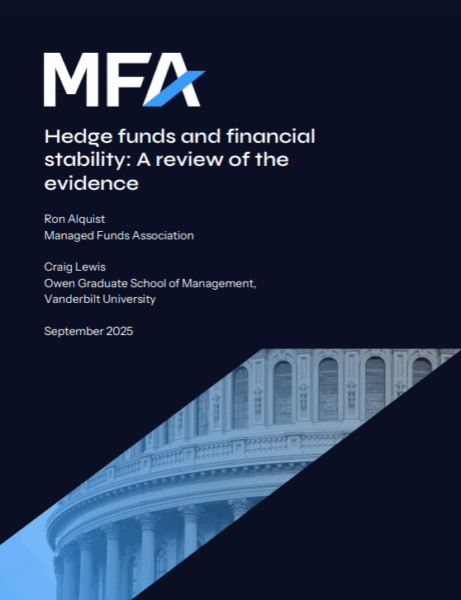Research paper: Hedge funds are not a source of systemic risk
Hedge funds are often seen as the thoroughbreds of global finance—fast-moving, deeply skilled, and always in the mix. So when markets wobble, it seems obvious that hedge funds must be part of the story.
But that assumption is wrong.
New research from the Managed Funds Association (MFA) shows that hedge funds have weathered the most severe market shocks of the past three decades without threatening financial stability. The study, Hedge Funds and Financial Stability: A Review of the Evidence, offers one of the most comprehensive reviews to date of how hedge funds interact with the broader financial system during times of stress.
Authored by Craig Lewis, Ph.D., Madison S. Wigginton Professor of Finance, Emeritus, at Vanderbilt University, and Ron Alquist, Ph.D., Managing Director, Research, at MFA, the paper reviews major episodes of market disruption, analyzes the mechanics of leverage and liquidity, and evaluates how post-crisis reforms have strengthened the resilience of the financial system.
Key findings:
1: Hedge fund distress does not pose a systemic risk
Over nearly three decades of market stress, there is little evidence that hedge funds have posed a systemic risk to the financial system. In fact, outside of the 1998 near-collapse of Long-Term Capital Management (LTCM) — an isolated case linked to excessive leverage, poor counterparty visibility, and risk management failures — no hedge fund episode since has threatened financial stability.

Subsequent episodes illustrate that hedge fund distress is typically contained or that hedge funds even help stabilize markets:
- Amaranth Advisors (2006): Amaranth experienced an orderly wind down despite failing after losing billions of dollars on wrong-way natural gas trades. Central clearing mechanisms absorbed losses, and counterparties were protected through strong margining and credit controls. The case showed how reforms implemented after LTCM, particularly around counterparty credit risk management, worked as intended, preventing contagion.
- The Quant Quake (2007): Several quantitative equity funds suffered severe but brief losses as similar trading strategies unwound over a few days. Prices quickly rebounded as other hedge funds and investors stepped in to exploit mispricings, restoring market balance. The event revealed vulnerabilities in crowded trading strategies, but not systemic fragility. It was a portfolio-management issue, not a market stability one.
- The Global Financial Crisis (2008): Despite widespread turmoil, hedge funds were not a source of contagion. Many reduced leverage early, managed liquidity conservatively, and in several markets acted as liquidity providers, purchasing distressed assets when traditional intermediaries pulled back. Hedge funds’ flexibility and active risk management helped limit systemic fallout rather than amplify it.
- The March 2020 “Dash for Cash”: Policymakers initially suspected hedge funds’ Treasury “basis trades” had worsened volatility. However, subsequent academic and central bank research paints a different picture. Hedge funds often absorbed selling pressure by maintaining or even adding to positions. Prices of “cheapest-to-deliver” Treasury securities—commonly held by hedge funds—rose relative to other bonds, indicating that funds were not dumping assets. Data show that mutual funds, pension funds, and foreign official accounts, not hedge funds, were the largest sellers. In UK gilt markets, hedge funds were net purchasers, providing liquidity to other market participants. The Bank of England’s stress testing found hedge funds’ direct market impact was limited and, in some cases, stabilizing.
- Archegos Capital Management (2021): Archegos’ collapse caused large losses for several banks, but it was not a hedge fund—it was a family office exempt from registration and reporting requirements. Unlike hedge funds, family offices are not subject to institutional investor oversight or regulatory reporting. Hedge funds operate with more robust risk management, including diversification, position limits, and real-time exposure monitoring—controls that likely would have prevented Archegos’s concentrated, opaque leverage.
Taken together, these examples demonstrate that hedge funds have acted as stabilizers, not destabilizers. They have absorbed losses, provided liquidity, and adjusted positions in line with strong risk management practices—helping markets normalize rather than unravel.

2: Hedge funds strengthen financial markets
The paper highlights the important functions hedge funds perform in capital markets, including enhancing market efficiency, supporting capital formation, and indirectly providing liquidity as a result of their investing activity:
- Enhancing market efficiency: Hedge funds actively identify and trade mispriced assets, improving price discovery and helping align asset prices with fundamentals.
- Supporting capital formation: By offering flexible financing solutions — such as convertible bond or credit investments — hedge funds enable companies, especially those with limited access to public markets, to raise capital more efficiently.
- Providing liquidity: Hedge funds indirectly provide liquidity by trading in complex and stressed markets, helping reduce volatility and enabling other investors to buy or sell assets when needed.
These activities make markets more resilient and efficient with the benefits ultimately flowing to investors such as pension funds, endowments, and foundations.
3: Post-crisis reforms have further reduced risk
The study also shows that the financial system today is far stronger and less vulnerable to potential stress posed by hedge funds than it was in the 1990s. Regulatory reforms following the global financial crisis have reinforced key safeguards:

- Stronger counterparty credit risk management (CCRM): Prime brokers and lenders now apply more rigorous risk assessment, margining, and monitoring of hedge fund exposures.
- Increased central clearing: Central clearing of derivatives has reduced contagion risk by preventing the kind of opaque bilateral exposures that amplified LTCM’s losses.
- Greater transparency: SEC Form PF and other regulatory reporting have given supervisors better visibility into aggregate exposures and potential risks.
These reforms, combined with improved internal risk management by funds and better capitalization of banks, have made the financial system more resilient and better equipped to absorb shocks.
Conclusion
Hedge funds play an important role in financial markets. They indirectly provide liquidity, correct mispricings, and support capital formation. The research confirms what decades of experience have shown: hedge funds are not a source of systemic risk. Rather, they are vital participants that make markets more efficient, competitive, and stable.

